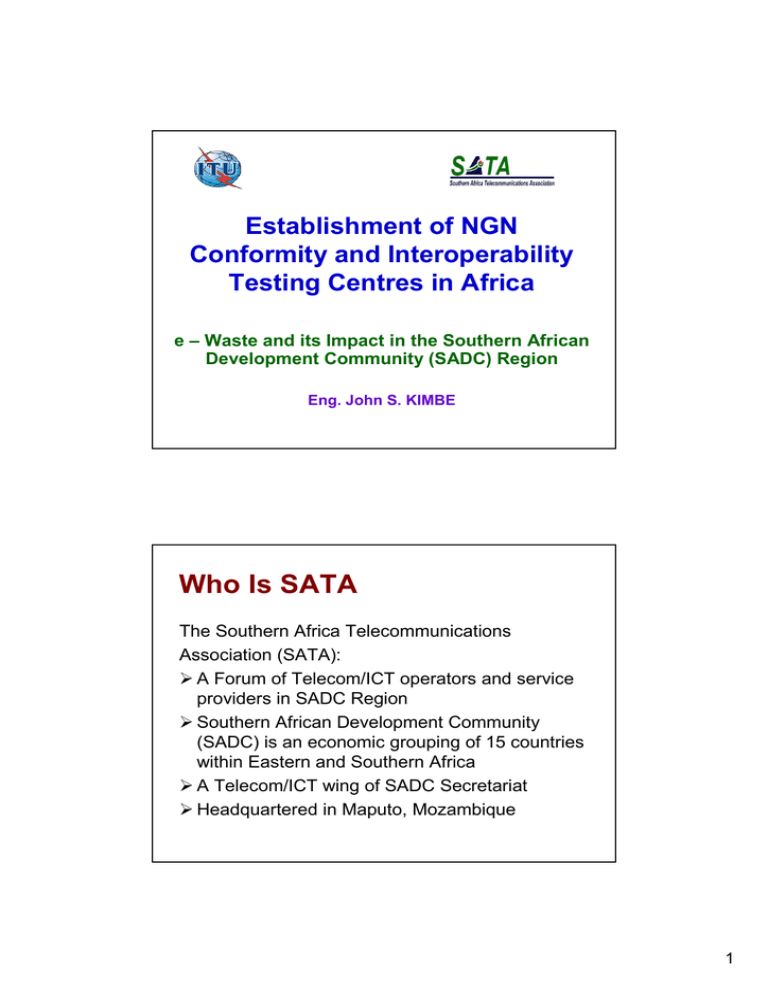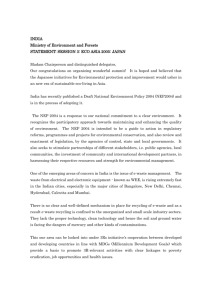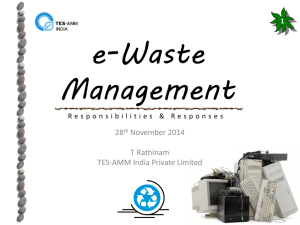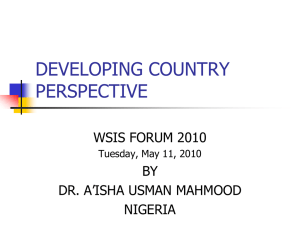Who Is SATA Establishment of NGN Conformity and Interoperability Testing Centres in Africa
advertisement

Establishment of NGN Conformity and Interoperability Testing Centres in Africa e – Waste and its Impact in the Southern African Development Community (SADC) Region Eng. John S. KIMBE Who Is SATA The Southern Africa Telecommunications Association (SATA): A Forum of Telecom/ICT operators and service providers in SADC Region Southern African Development Community (SADC) is an economic grouping of 15 countries within Eastern and Southern Africa A Telecom/ICT wing of SADC Secretariat Headquartered in Maputo, Mozambique 1 SADC Member States and SATA Members This year, we are celebrating 30 years since the establishment of of SATA and its mother body - SADC Drivers of e-Waste The electrical and electronic waste (e-waste): One of the fastest growing waste streams in the world; Increasing “market penetration” in developing countries, “replacement market” in developed countries and “high obsolescence rate” make ewaste as one of the fastest growing waste streams; Environmental issues and trade associated with e-waste at local, trans-boundary and international level has driven many countries to introduce interventions 2 Maseru Resolution on e-Waste At its 30th SATA Annual Conference in April 2010 in Maseru, Lesotho, the SATA Chief Executive Officers raised concern on the amount of equipment that will be laid idle after migration process from the legacy networks into next Generation Networks (NGN); Decided that there was a need to facilitate the recovery and/or reuse of useful materials from waste; Directed the SATA Secretariat to come up with Regional Guidelines on e-Waste disposal covering the Reduce, Reuse, Recycle (R3) approach. Response to Maseru Resolution SATA Secretariat has already embarked into the drafting of the Guidelines for e-Waste disposal The objective is to provide guidance for identification of various sources of electrical and electronic equipments waste (e-waste) and prescribed procedures for handling ewaste; Guidelines also call for an establishment of SADC eWaste Recycling Plant Considering the high recyclable potential of e-waste such wastes should be subject to recycling in an environmentally sound manner; These Guidelines shall apply to all those in the region who handle e-waste which includes the generators, collectors, transporters, dismantlers, recyclers and stakeholders of ewastes irrespective of their scale of operation. 3 Composition of e-Waste e - Waste comprises of: Wastes generated from used electronic devices and house hold appliances which are not fit for their original intended use and are destined for recovery, recycling or disposal; Such wastes encompass wide range of electrical and electronic devices such as computers, hand held cellular phones, personal stereos, large household such as refrigerators, air conditioners etc.; e - wastes contain over 1000 different substances many of which are toxic and potentially hazardous to environment and human health, if they are not handled in an environmentally sound manner. The Current “End of Life” Management in the SADC Region is: Stockpile Incinerate/Burn Landfill/Dumping Recycling is still a dream 4 According to Silicon Valley Toxics Coalition and the Basel Action Network up to 80% of equipment headed for recycling in US is sent overseas Diversity of e-Waste Composition Composition of e-waste is very diverse and differs in products across different categories. Broadly, it consists of: Ferrous and non-ferrous metals, plastics, glass, wood & plywood, printed circuit boards, concrete and ceramics, rubber and other items; Iron and steel constitutes about 50% of the e-waste followed by plastics (21%), non ferrous metals (13%) and other constituents; Non-ferrous metals consist of metals like copper, aluminum and precious metals such as silver, gold, platinum, palladium etc.; The presence of elements like lead, mercury, arsenic, cadmium, selenium, and chromium and flame retardants beyond threshold quantities in e-waste classifies them as hazardous waste and threat to human race, plants and other creatures. 5 e-Waste Export to Developing World e - Waste is routinely exported by developed countries to developing ones (Africa and Asia), often in violation of the international law; In the 1990s, governments in the EU, Japan and some US states set up e-waste 'recycling' systems. But many countries did not have the capacity to deal with the sheer quantity of e-waste they generated or with its hazardous nature; Therefore, they began exporting the problem to developing countries where laws to protect workers and the environment are inadequate or not enforced; It is also cheaper to 'recycle' waste in developing countries; for example the cost of glass-to-glass recycling of computer monitors in the US is 10 times more than in China. International Conventions on Waste Management There are two key international conventions regulating waste management, namely the Basel and Bamako Conventions. The Conventions emphasise that: Signatories must ensure that the generation of hazardous wastes, and other wastes within a country, is reduced to a minimum, taking into account social, technological and economic aspects; If a country exporting the hazardous waste does not have the technical capacity, necessary facilities, or suitable disposal sites to dispose of the waste in question in an environmentally sound and efficient manner, steps must be taken to minimize pollution and its health consequences as far as possible. 6 Bamako Convention on Waste The Bamako Convention (in full: Bamako Convention on the ban on the Import into Africa and the Control of Transboundary Movement and Management of Hazardous Wastes within Africa) is a treaty of African nations prohibiting the import of any hazardous waste; The Convention was negotiated by twelve nations of the OAU now AU at Bamako, Mali in January, 1991, and came into force in 1998; Bamako Convention arose from the failure of the Basel Convention to prohibit trade of hazardous waste to Least Developed Countries (LDCs), and from the realization that many developed nations were exporting toxic wastes to Africa; Strengths of Bamako Convention The failure of Basel Convention was evidenced by several prominent cases. One case, occurred in 1987, concerned the importation into Nigeria of 18,000 barrels of hazardous waste from a European Company , promising to pay a local farmer $100 per month for storage. The barrels, found in storage in the port of Lagos contained toxic waste including polychlorinated biphenyls, which were shipped back to the country of origin; The Bamako Convention uses a language similar to that of the Basel Convention, but is much stronger in prohibiting all imports of hazardous waste; The Bamako Convention does not make exceptions on certain hazardous wastes (like those for radioactive materials) made by the Basel Convention. 7 Other “Similar” Conventions The Rotterdam Convention is a multilateral treaty to promote shared responsibilities in relation to importation of hazardous chemicals. The convention promotes open exchange of information and calls on exporters of hazardous chemicals to use proper labeling, include directions on safe handling, and inform purchasers of any known restrictions or bans. The Stockholm Convention is an international environmental treaty that aims to eliminate or restrict the production and use of Persistent Organic Pollutants (POPs). Need for SADC Regional Guidelines on e-Waste Management Increasing amount of e-Waste in the Region; Associated Toxic Components in e-Waste; Lack of environmentally sound recycling infrastructure; Lack of Policy and Regulation for e-Waste Management The potential of increased e-waste generation and lack of adequate recycling facilities have attracted the attention of a number of recyclers globally, thus expressing interest to start recycling facility in the Southern African Development Community (SADC) under SATA Initiative. 8 Case Study: e-Waste in South Africa The e-Waste Association of South Africa (e-WASA) is currently establishing a sustainable e-waste collection and recycling scheme for the country; A 2008 e-WASA commissioned study estimates that consumer electronics and IT in South African homes amount to anything between 1 and 2 million tonnes, most of which is likely to enter the waste stream in the next 5 to 10 years; The survey suggests that the top 10% of households by income generate nearly 100,000 tonnes of e-waste each year across all product categories; Of these 100,000-plus tonnes of e-waste, formal recyclers in South Africa process approximately 20,000 tonnes, leaving the rest to be dumped illegally. e – Waste Recyclers in South Africa Recyclers processing ferrous and non-ferrous metals have been operating in South Africa for decades, (since 1990s); Recently, new e-waste recyclers have emerged; There is also some degree of specialization, with technology imported into the country to deal with, for example, fluorescent discharge lamps; Recycling processes used by these operators are not uniform, and include mainly manual dismantling and, in a few cases, mechanized shredding; Solutions are not available, however, for the proper handling of cathode ray tubes (CRTs), brominated plastics and printed circuit boards. 9 Stockpiling of computer monitors in the backyard of an e-waste recycler in South Africa. South Africa doesn’t have a sustainable solution for the recycling of cathode ray tubes e – Waste Regulation in South Africa There is currently no specific legislation to deal with e-waste in South Africa; However, the new National Environmental Management Waste Bill provides several definitions which can be read as having an impact on e-waste; The legislation is limited to waste streams that are not dealt with by other pieces of legislation in order to avoid duplication and to complement existing legislation; Industry-led waste management plans are encouraged. 10 NGN Conformity and Interoperability Testing Why need Testing? How Testing will reduce e – Waste in Africa Standards are Insufficient Standards not enough to ensure interoperability – Standards only meaningful if implemented in a consistent way Need to ensure that implementations adhere to the standards – What is expected of implementations in order to claim conformance – i.e., what are the requirements? – How will we know if an implementation conforms? • test beds, test tools Conformance is necessary but not sufficient for interoperability Interoperability does not imply conformance 11 Terminologies CONFORMITY – the fulfillment of a product, process or service of specified requirements; independent condition INTEROPERABILITY – is a property referring to the ability of diverse systems to work together (interoperate or inter-work); interdependent condition CONFORMITY TESTING – a way to determine directly or indirectly that relevant requirements are fulfilled. INTEROPERABILITY TESTING – a way to determine that 2 or more systems or components can exchange information and use the information that has been exchanged. Conformance Testing Tests a single component of a product for conformity to a base standard (specification) - Tests standardized (specified) requirements and supported options Tests over interfaces exposed for testing Works at a 'low' level - Usually at the protocol (message/behaviour) level - Usually tests specific paths through a protocol Requires a test system (and executable test cases) Traditionally the telecoms industry performs conformance testing 12 Interoperability Testing Shows two implementations interoperating with each other - to the extent defined by the interoperability test cases Tests Functionality of an entire product - High-level (as perceived by users) - Shows function is accomplished (but not how) Exercises each necessary component or subsystem - Regardless of whether the component was specified in a standard or not Exercises the interfaces between each necessary component or sub-systems - Regardless of whether the interface is in the public domain or not. IP world tends to go for interoperability testing NGN Conformity & Interoperability Testing in Africa Rapid growth and change of technology in developed world leaves a lot of e-articles; The obsolete e-articles are sold to Africa (where they look new/modern); Most e-articles that arrive in Continent are independent from the existing (no interoperability) typical examples are the switching and transmission equipment; The arrival of a “new” e-article means throwing away the existing “old” e-article. NGN systems pose even greater risk of nonconformity and non-interoperability 13 Conformity & Interoperability Testing in Africa – What is it? NGN Conformity & Interoperability Testing in Africa is to ensure that the new system respects the existing and the expected or future systems while behaving itself by providing the expected outcomes Backward – Present – Forward Looking Effective System Use – money back Reduce e-Waste Reduce Health Risks NGN Specimen Interoperate with existing systems Delivering the necessary services as mandated while back-looking and forward ready Future Systems (Unknown) REDUCED e – WASTE; REDUCED HEALTH RISK 14







